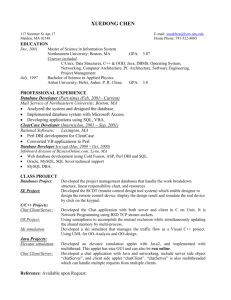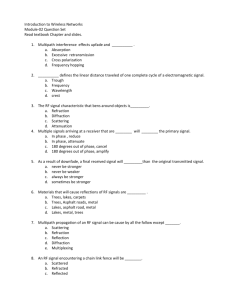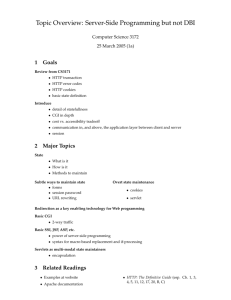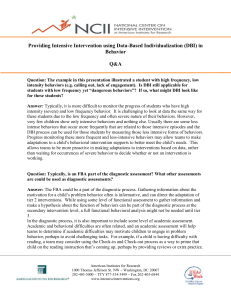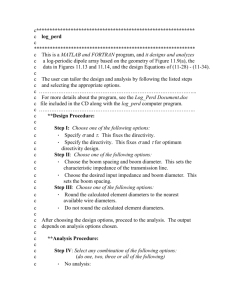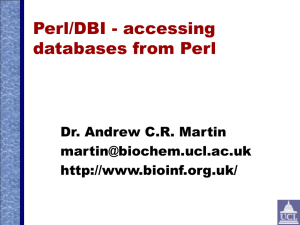Integrating Perl and Databases - CPAN
advertisement
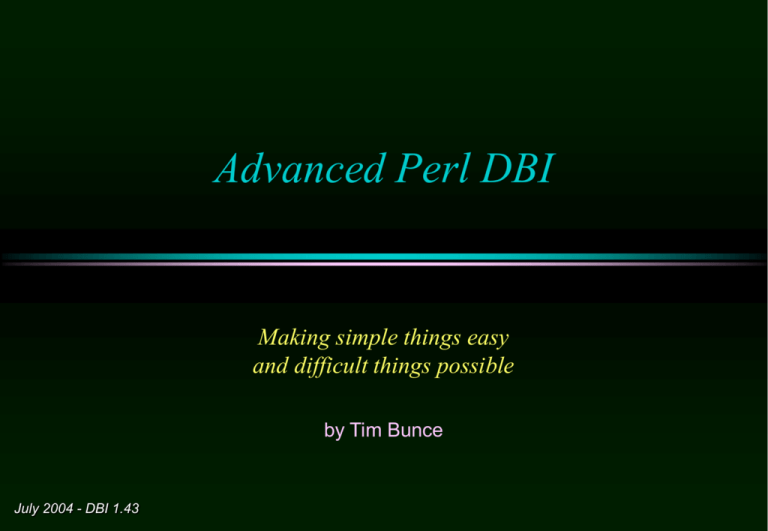
Advanced Perl DBI
Making simple things easy
and difficult things possible
by Tim Bunce
July 2004 - DBI 1.43
Advanced DBI tutorial
© Tim Bunce
July 2004
Topical Topics
Speed Speed Speed!
Handling handles and binding values
Error checking and error handling
Transactions
Architecture and Tracing
DBI for the web
Bulk operations
Tainting
Handling LONG/BLOB data
Portability
Proxy power and flexible multiplex
What’s planned
2
Advanced DBI tutorial
© Tim Bunce
July 2004
Trimmed Topics and Tips
Lack of time prevents the inclusion of ...
Details of issues relating to specific databases and drivers
– (other than where used as examples of general issues)
– each driver would warrant a tutorial of its own!
But I hope you’ll agree that there’s ample information
Non-trivial worked examples
Handy DBIx::* and other DBI related modules
… and anything I’d not finished implementing when this was written …
in the following 90+ slides…
Tips for those attending the conference tutorial:
Doodle notes from my whitterings about the ‘whys and wherefores’ on your
printed copy of the slides as we go along...
3
Advanced DBI tutorial
© Tim Bunce
July 2004
The DBI - What’s it all about?
The Perl DBI defines and implements an interface to databases
Plug-in driver modules do the database-specific work
DBI provides default methods, functions, tools etc for drivers
Not limited to the lowest common denominator
The Perl DBI has built-in…
Automatic error checking
Detailed call tracing/debugging
Flexible call profiling/benchmarking
Designed and built for speed
4
Advanced DBI tutorial
© Tim Bunce
July 2004
A picture is worth?
Perl Application
DBI Module
DBD::Oracle
Oracle Server
DBD::Informix
Informix Server
DBD::Other
Other Server
5
Speed
Speed
Speed!
What helps,what doesn't,
and how to measure it
Advanced DBI tutorial
© Tim Bunce
July 2004
Give me speed!
DBI was designed for speed from day one
DBI method dispatcher written in hand-crafted XS/C
Dispatch to XS driver method calls is specially optimized
Cached attributes returned directly by DBI dispatcher
DBI overhead is generally insignificant
– So we'll talk about other speed issues instead ...
7
Advanced DBI tutorial
© Tim Bunce
July 2004
Partition for speed
Start at the beginning
Pick the right database for the job, if you have the choice.
Understand the performance issues in schema design.
Application partitioning: Do What Where?
Work close to the data
– Moving data to/from the client is always expensive
– Consider latency as well as bandwidth
– Use stored procedures where appropriate
– Do more in SQL where appropriate - get a good book
Multiple simple queries with 'joins' in Perl may be faster.
Proprietary bulk-load is almost always faster than Perl.
Caching is valuable, in memory or DBM file etc, e.g. Memoize.pm
Mix 'n Match techniques as needed
– experiment and do your own benchmarks
.
8
Advanced DBI tutorial
© Tim Bunce
July 2004
Prepare for speed
prepare() - what happens in the server...
– Receive and parse the SQL statement into internal form
– Get details for all the selected tables
– Check access rights for each
– Get details for all the selected fields
– Check data types in expressions
– Get details for the indices on all the fields in where/join clauses
– Develop an optimised query 'access plan' for best execution
– Return a handle for all this cached information
This can be an expensive process
– especially the 'access plan’ for a complex multi-table query
Some databases, like MySQL, don't cache the information
– but have simpler and faster, but less powerful, plan creation
.
9
Advanced DBI tutorial
© Tim Bunce
July 2004
The best laid plans
Query optimisation is hard
– Intelligent high quality cost based query optimisation is really hard!
Know your optimiser
– Oracle, Informix, Sybase, DB2, SQL Server etc. all slightly different.
Check what it's doing
– Use tools to see the plans used for your queries - very helpful
Help it along
Most 'big name' databases have a mechanism to analyse and store the key
distributions of indices to help the optimiser make good plans.
– Important for tables with ‘skewed’ (uneven) key distributions
– Beware: keep it fresh, old key distributions might be worse than none
Some also allow you to embed 'hints' into the SQL as comments
– Beware: take it easy, over hinting hinders dynamic optimisation
.
10
Advanced DBI tutorial
© Tim Bunce
July 2004
MySQL’s EXPLAIN PLAN
To generate a plan:
EXPLAIN SELECT tt.TicketNumber, tt.TimeIn,
tt.ProjectReference, tt.EstimatedShipDate,
tt.ActualShipDate, tt.ClientID,
tt.ServiceCodes, tt.RepetitiveID,
tt.CurrentProcess, tt.CurrentDPPerson,
tt.RecordVolume, tt.DPPrinted, et.COUNTRY,
et_1.COUNTRY, do.CUSTNAME
FROM tt, et, et AS et_1, do
WHERE tt.SubmitTime IS NULL
AND tt.ActualPC = et.EMPLOYID
AND tt.AssignedPC = et_1.EMPLOYID
AND tt.ClientID = do.CUSTNMBR;
The plan is described using results like this:
TABLE
et
tt
et_1
do
TYPE
ALL
ref
eq_ref
eq_ref
POSSIBLE_KEYS
PRIMARY
AssignedPC,ClientID,ActualPC
PRIMARY
PRIMARY
KEY
NULL
ActualPC
PRIMARY
PRIMARY
KEY_LEN
NULL
15
15
15
REF
NULL
et.EMPLOYID
tt.AssignedPC
tt.ClientID
ROWS
74
52
1
1
EXTRA
where used
11
Advanced DBI tutorial
© Tim Bunce
July 2004
Oracle’s EXPLAIN PLAN
To generate a plan:
EXPLAIN PLAN SET STATEMENT_ID = 'Emp_Sal’ FOR
SELECT ename, job, sal, dname
FROM emp, dept
WHERE emp.deptno = dept.deptno
AND NOT EXISTS
(SELECT * FROM salgrade
WHERE emp.sal BETWEEN losal AND hisal);
That writes plan details into a table which can be queried to yield results like this:
ID PAR Query Plan
--- --- -------------------------------------------------0
Select Statement
Cost = 69602
1
0
Nested Loops
2
1
Nested Loops
3
2
Merge Join
4
3
Sort Join
5
4
Table Access Full T3
6
3
Sort Join
7
6
Table Access Full T4
8
2
Index Unique Scan T2
9
1
Table Access Full T1
12
Advanced DBI tutorial
© Tim Bunce
July 2004
Changing plans (hint hint)
Most database systems provide a way to influence the execution plan
typically via ‘hints’
Oracle supports a very large and complex range of hints
Hints must be contained within special comments /*+ … */
SELECT /*+ INDEX(table1 index1) */ foo, bar
FROM table1 WHERE key1=1 AND key2=2 AND key3=3;
MySQL has a very limited set of hints
Hints can optionally be placed inside comments /*! … */
SELECT foo, bar FROM table1 /*! USE INDEX (key1,key2) */
WHERE key1=1 AND key2=2 AND key3=3;
Use sparingly! Generally as a last resort.
.
A hint may help now but later schema (or data) changes may make it worse.
Usually best to let the optimizer do its job
14
Advanced DBI tutorial
© Tim Bunce
July 2004
Respect your server's SQL cache
Optimised Access Plan and related data
– is cached within the server (for Oracle etc, but not MySQL etc)
– keyed by the exact original SQL string used
do("insert … $id");
do("insert … ?", undef, $id);
Compare
with
Without placeholders, SQL string varies each time
– so cached one is not reused
– so time is wasted creating a new access plan
– the new statement and access plan are added to cache
– so the cache fills and other statements get pushed out
– on a busy system this can lead to ‘thrashing’
Oracle now has a way to avoid/reduce this problem
– it can effectively replace literal constants with placeholders
– but the quality of query execution plans can suffer
.
15
Advanced DBI tutorial
© Tim Bunce
July 2004
Hot handles
Avoid using $dbh->do(…) in a speed-critical loop
– It’s usually creating and destroying a statement handle each time
Use $sth = $dbh->prepare(…)and $sth->execute() instead
Using prepare() gets a handle on the statement in the SQL cache
– Avoids a round-trip to server for SQL cache check on each use
For example… convert looped
into
and
$dbh->do("insert … ?", undef, $id)
$sth = $dbh->prepare("insert … ?”) before the loop
$sth->execute($id) inside the loop
This often gives a significant performance boost
– even where placeholders are emulated, such as the current DBD::mysql
– because it avoids statement handle creation overhead
.
16
Advanced DBI tutorial
© Tim Bunce
July 2004
Sling less for speed
while(@row = $sth->fetchrow_array) { }
while($row = $sth->fetchrow_arrayref) { }
one column: 58,653 fetches per second - approximately 12% faster
20 columns: 49,390 fetches per second - approximately 51% faster
while($row = shift(@$rowcache)
one column: 51,155 fetches per second
20 columns: 24,032 fetches per second
|| shift(@{$rowcache=$sth->fetchall_arrayref(undef, $max_rows)})) { }
one column: 348,140 fetches per second - by far the fastest!
20 columns: 42,128 fetches per second - now slower than fetchrow_arrayref!
Why? Balance time saved making fewer calls with time spent managing more memory
Do your own benchmarks to find what works best for your situations
Notes:
Tests used DBD::mysql on 100,000 rows with fields 9 chars each. $max_rows=1000;
Time spent inside fetchrow_* method is approximately 0.000011s (~90,000 per second)
17
Advanced DBI tutorial
© Tim Bunce
July 2004
Bind those columns!
Compare
while($row = $sth->fetchrow_arrayref) {
print “$row->[0]: $row->[1]\n”;
}
with
$sth->bind_columns(\$key, \$value);
while($sth->fetchrow_arrayref) {
print “$key: $value\n”;
}
No row assignment code!
No column access code!
... just magic
18
Advanced DBI tutorial
© Tim Bunce
July 2004
Do more with less!
Reduce the number of DBI calls
– The DBI is fast -- but it isn’t free!
Using RaiseError is faster than checking return values
– and much faster than checking $DBI::err or $h->err
Using fetchall_arrayref (or selectall_arrayref) is now much faster
– if using a driver extension compiled with the DBI’s Driver.xst wrapper (most are)
– because the loop is written in C and doesn’t make a method call per row
Using fetchall_arrayref is possible for very large result sets
– new $max_rows parameter limits rows returned (and memory consumed)
– just add an outer loop to process the results in ‘batches’, or do it in-line:
$row = shift(@$cache)
|| shift @{$cache=$sth->fetchall_arrayref(undef, 1000)};
19
Advanced DBI tutorial
© Tim Bunce
July 2004
Speedy Summary
Think about the big picture first
– Choice of tools, schema design, partitioning, latency, etc.
Check and tune the access plans for your statements
– Teach your database about any uneven key distributions
Use placeholders - where supported
– Especially for any statements that vary and will be executed often
Replace do() in a loop
– with prepare() and execute()
Sling less data for faster row fetching
– Or sling none per row by binding columns to perl variables
Do more with less by using the DBI in the most efficient way
– Make fewer, better, DBI method calls
Other important things to consider…
– your perl code, plus hardware, operating system, and database configuration etc.
-
20
Advanced DBI tutorial
© Tim Bunce
July 2004
Optimizing Perl - Some Tips
Perl is fast, but not that fast...
Still need to take care with apparently simple things in 'hot' code
– Function/method calls have significant overheads per call.
– Copying data also isn't cheap, especially long strings (allocate and copy)
– Perl compiles to 'op codes' then executes them in a loop...
– The more ops, the slower the code (all else being roughly equal).
– Try to do more with fewer ops. Especially if you can move loops into ops.
Key techniques include:
– Caching at many levels, from common sub-expression elimination to web caching
– Functional programming: @result = map { … } grep { … } @data;
But don't get carried away... only optimize hot code, and only if needed
– Don't optimize for performance at the cost of maintenance. Learn perl idioms.
– Beware "Compulsive Tuning Disorder" - Gaja Krishna Vaidyanatha
– And remember that "Premature optimization is the root of all evil" - Donald Knuth
21
Profiling DBI Performance
Time flies like an arrow
(fruit flies like a banana)
Advanced DBI tutorial
© Tim Bunce
July 2004
How fast was that?
The DBI now has performance profiling built in
Easiest to demonstrate by example...
Overall summary:
$ DBI_PROFILE=1 test.pl
DBI::Profile: 0.010782s 1.05% (15 calls) test.pl @ 2004-07-01 10:25:37
Breakdown by statement:
$ DBI_PROFILE=2 test.pl
DBI::Profile: 0.010842s 1.80% (15 calls) test.pl @ 2004-07-01 10:26:15
'' =>
0.007768s / 9 = 0.000863s avg (first 0.000022s, min 0.000022s, max 0.007444s)
'INSERT INTO prices (prod_id,price) VALUES(?,?)' =>
0.001715s / 4 = 0.000429s avg (first 0.000587s, min 0.000040s, max 0.000612s)
'UPDATE prices SET price=? WHERE prod_id=?' =>
0.001359s / 2 = 0.000680s avg (first 0.000404s, min 0.000404s, max 0.000955s)
23
Advanced DBI tutorial
© Tim Bunce
July 2004
How fast was what?
Breakdown by statement and method:
$ DBI_PROFILE=6 test.pl
(only part of output is shown here)
'UPDATE prices SET price=? WHERE prod_id=?' =>
'execute' =>
0.000951s
'prepare' =>
0.000404s
Some key points
Only profiles ‘top level’ calls from application, not ‘recursive’ calls from within DBI/DBD.
Timing data is collected and merged into a $h->{Profile}{…}{…} data tree
All handles share the same data tree by default - giving one overall set of results
The ‘path’ through the tree to where the data is merged-in can be dynamically controlled
By default $dbh method calls are usually associated with the $dbh->{Statement} string
DBI::Profile can be subclassed (e.g., DBI::ProfileDumper for mod_perl)
Applications can add their own timing data
More features than I can fit on the slide...
24
Attribution
Names and Places
Advanced DBI tutorial
© Tim Bunce
July 2004
Attribution - For Handles
Two kinds of attributes: Handle Attributes and Method Attributes
A DBI handle is a reference to a hash
Handle Attributes can be read or set by accessing the hash via the reference
$h->{AutoCommit} = 0;
$autocomitting = $h->{AutoCommit};
Some attributes are read-only
$sth->{NUM_OF_FIELDS} = 42; # fatal error
Using an unknown attribute triggers a warning
$sth->{AutoCommat} = 42; # triggers a warning
$autocomitting = $sth->{AutoCommat}; # triggers a warning
– driver-private attributes (which have lowercase names) do not trigger a warning
26
Advanced DBI tutorial
© Tim Bunce
July 2004
Attribution - For Methods
Two kinds of attributes: Handle Attributes and Method Attributes
Many DBI methods take an ‘attributes’ parameter
– in the form of a reference to a hash of key-value pairs
The attributes parameter is typically used to provide ‘hints’ to the driver
– Unrecognised attributes are simply ignored
– So invalid attribute name (like typos) won't be caught
The method attributes are generally unrelated to handle attributes
– The connect() method is an exception
– In DBI v2 prepare() will also accept handle attributes for the new handle
27
Advanced DBI tutorial
© Tim Bunce
July 2004
What’s in a name?
The letter case used for attribute names is significant
– plays an important part in the portability of DBI scripts
Used to signify who defined the meaning of that name and its values
Case of name
UPPER_CASE
MixedCase
lower_case
Has a meaning defined by
Formal standards, e.g., X/Open, SQL92 etc (portable)
DBI API (portable), underscores are not used.
Driver specific, ‘private’ attributes (non-portable)
Each driver has its own prefix for its private method and handle attributes
– Ensures two drivers can’t define different meanings for the same attribute
$sth->bind_param( 1, $value, { ora_type => 97, ix_type => 42 } );
28
Handling your Handles
Get a grip
Advanced DBI tutorial
© Tim Bunce
July 2004
Let the DBI cache your handles
Sometimes it's not easy to hold all your handles
– e.g., library code to lookup values from the database
The prepare_cached() method
– gives you a client side statement handle cache:
sub lookup_foo {
my ($dbh, $id) = @_;
$sth = $dbh->prepare_cached("select foo from table where id=?");
return $dbh->selectrow_array($sth, $id);
}
On later calls returns the previously cached handle
– for the given statement text and any method attributes
Can avoid the need for global statement handle variables
– which can cause problems in some situations, see later
30
Advanced DBI tutorial
© Tim Bunce
July 2004
Some prepare_cached() issues
A cached statement handle may still be Active
because some other code is still fetching from it
or didn't fetch all the rows (and didn't didn't call finish)
perhaps due to an exception
Default behavior for prepare_cached()
if Active then warn and call finish()
Rarely an issue in practice
But if it is
Alternative behaviors are available via the $is_active parameter
prepare_cached($sql, \%attr, $if_active)
See the docs for details
31
Advanced DBI tutorial
© Tim Bunce
July 2004
Keep a handle on your databases
Connecting to a database can be slow
– Oracle especially so
Try to connect once and stay connected where practical
– We'll discuss web server issues later
The connect_cached() method …
Acts like prepare_cached() but for database handles
Like prepare_cached(), it’s handy for library code
It also checks the connection and automatically reconnects if it's broken
Works well combined with prepare_cached(), see following example
.
32
Advanced DBI tutorial
© Tim Bunce
July 2004
A connect_cached() example
Compare and contrast...
my $dbh = DBI->connect(…);
sub lookup_foo_1 {
my ($id) = @_;
$sth = $dbh->prepare_cached("select foo from table where id=?");
return $dbh->selectrow_array($sth, $id);
}
with...
sub lookup_foo_2 {
my ($id) = @_;
my $dbh = DBI->connect_cached(…);
$sth = $dbh->prepare_cached("select foo from table where id=?");
return $dbh->selectrow_array($sth, $id);
}
Clue: what happens if the database is restarted?
33
Advanced DBI tutorial
© Tim Bunce
July 2004
Some connect_cached() issues
Because connect_cached() may return a new connection...
it’s important to specify all significant attributes within the connect() call
e.g., AutoCommit, RaiseError, PrintError
So pass the same set of attributes into all connect calls
Similar, but not quite the same as Apache::DBI
Doesn’t disable the disconnect() method.
The caches can be accessed via the CachedKids handle attribute
$dbh->{CachedKids}
- for prepare_cached()
$dbh->{Driver}->{CachedKids}
- for connect_cached()
Could also be tied to implement LRU and other size-limiting caching strategies
tie %{$dbh->{CachedKids}}, SomeCacheModule
_
34
Binding (Value Bondage)
Placing values in holders
Advanced DBI tutorial
© Tim Bunce
July 2004
First, the simple stuff...
After calling prepare() on a statement with placeholders:
$sth = $dbh->prepare(“select * from table where k1=? and k2=?”);
Values need to be assigned (‘bound’) to each placeholder before the
database can execute the statement
Either at execute, for simple cases:
$sth->execute($p1, $p2);
or before execute:
$sth->bind_param(1, $p1);
$sth->bind_param(2, $p2);
$sth->execute;
36
Advanced DBI tutorial
© Tim Bunce
July 2004
Then, some more detail...
If $sth->execute(…) specifies any values, it must specify them all
Bound values are sticky across multiple executions:
$sth->bind_param(1, $p1);
foreach my $p2 (@p2) {
$sth->bind_param(2, $p2);
$sth->execute;
}
The currently bound values are retrievable using:
%bound_values = %{ $sth->{ParamValues} };
– Relatively new DBI feature, added in 1.28, not implemented by all drivers yet
37
Advanced DBI tutorial
© Tim Bunce
July 2004
Your TYPE or mine?
Sometimes the data type for bind values needs to be specified
use DBI qw(:sql_types);
– to import the type constants
$sth->bind_param(1, $value, { TYPE => SQL_INTEGER });
– to specify the INTEGER type
– which can be abbreviated to:
$sth->bind_param(1, $value, SQL_INTEGER);
To just distinguish numeric versus string types, try
$sth->bind_param(1, $value+0);
# bind as numeric value
$sth->bind_param(1, ”$value”);
# bind as string value
– Works because perl values generally know if they are strings or numbers. So...
– Generally the +0 or ”” isn’t needed because $value has the right ‘perl type’ already
38
Advanced DBI tutorial
© Tim Bunce
July 2004
Got TIME for a DATE?
Date and time types are strings in the native database format
Obvious need for a common format
many valid formats, some incompatible or ambiguous 'MM/DD/YYYY' vs 'DD/MM/YYYY'
The SQL standard (ISO 9075) uses 'YYYY-MM-DD' and 'YYYY-MM-DD HH:MM:SS'
DBI now says using a date/time TYPE mandates ISO 9075 format
$sth->bind_param(1, "2004-12-31", SQL_DATE);
$sth->bind_param(2, "2004-12-31 23:59:59", SQL_DATETIME);
$sth->bind_col(1, \$foo, SQL_DATETIME); # for selecting data
Driver is expected to convert to/from native database format
.
New feature, as of DBI 1.43, not yet widely supported
39
Advanced DBI tutorial
© Tim Bunce
July 2004
Some TYPE gotchas
Bind TYPE attribute is just a hint
– and like all hints in the DBI, they can be ignored
– the driver is unlikely to warn you that it's ignoring an attribute
Many drivers only care about the number vs string distinction
– and ignore other kinds of TYPE value
For some drivers/databases that do pay attention to the TYPE…
– using the wrong type can mean an index on the value field isn’t used
Some drivers let you specify private types
$sth->bind_param(1, $value, { ora_type => 97 });
-
40
Error Checking & Error Handling
To err is human,
to detect, divine!
Advanced DBI tutorial
© Tim Bunce
July 2004
The importance of error checking
Errors happen!
Failure happens when you don't expect errors!
– database crash / network disconnection
– lack of disk space for insert or select (sort space for order by)
– server math error on select (divide by zero after fetching 10,000 rows)
– and maybe, just maybe, errors in your own code [Gasp!]
Beat failure by expecting errors!
Detect errors early to limit effects
– Defensive Programming, e.g., check assumptions
– Through Programming, e.g., check for errors after fetch loops
(and undefined values are your friends: always enable warnings)
.
42
Advanced DBI tutorial
© Tim Bunce
July 2004
Error checking - ways and means
Error checking the hard way...
$h->method or die "DBI method failed: $DBI::errstr";
$h->method or die "DBI method failed: $DBI::errstr";
$h->method or die "DBI method failed: $DBI::errstr";
Error checking the smart way...
$h->{RaiseError} = 1;
$h->method;
$h->method;
$h->method;
43
Advanced DBI tutorial
© Tim Bunce
July 2004
Handling errors the smart way
Setting RaiseError make the DBI call die for you
For simple applications immediate death on error is fine
– The error message is usually accurate and detailed enough
– Better than the error messages some developers use!
For more advanced applications greater control is needed, perhaps:
– Correct the problem and retry
– or, Fail that chunk of work and move on to another
– or, Log error and clean up before a graceful exit
– or, whatever else to need to do
Buzzwords:
– Need to catch the error exception being thrown by RaiseError
.
44
Advanced DBI tutorial
© Tim Bunce
July 2004
Catching the Exception
Life after death
$h->{RaiseError} = 1;
eval {
foo();
$h->method;
# if it fails then the DBI calls die
bar($h);
# may also call DBI methods
};
if ($@) {
# $@ holds error message
... handle the error here …
}
Bonus
– Other, non-DBI, code within the eval block may also raise an exception
– that will also be caught and can be handled cleanly
.
45
Advanced DBI tutorial
© Tim Bunce
July 2004
Picking up the Pieces
So, what went wrong?
$@
– holds the text of the error message
if ($DBI::err && $@ =~ /^(\S+) (\S+) failed: /)
– then it was probably a DBI error
– and $1 is the driver class (e.g. DBD::foo::db), $2 is the name of the method (e.g. prepare)
$DBI::lasth
– holds last DBI handle used (not recommended for general use)
$h->{Statement}
– holds the statement text associated with the handle (even if it’s a database handle)
$h->{ShowErrorStatement} = 1
– appends $h->{Statement} to RaiseError/PrintError messages:
– DBD::foo::execute failed: duplicate key [for ``insert …’’]
– for statement handles it also includes the $h->{ParamValues} if available.
– Makes error messages much more useful. Better than using $DBI::lasth
– Many drivers should enable it by default. Inherited by child handles.
46
Advanced DBI tutorial
© Tim Bunce
July 2004
Custom Error Handling
Don’t want to just Print or Raise an Error?
Now you can Handle it as well…
$h->{HandleError} = sub { … };
The HandleError code
is called just before PrintError/RaiseError are handled
it’s passed
– the error message string that RaiseError/PrintError would use
– the DBI handle being used
– the first value being returned by the method that failed (typically undef)
if it returns false then RaiseError/PrintError are checked and acted upon as normal
The handler code can
alter the error message text by changing $_[0]
use caller() or Carp::confess() or similar to get a stack trace
use Exception or a similar module to throw a formal exception object
47
Advanced DBI tutorial
© Tim Bunce
July 2004
More Custom Error Handling
It is also possible for HandleError to hide an error, to a limited degree
– use set_err() to reset $DBI::err and $DBI::errstr
– alter the return value of the failed method
$h->{HandleError} = sub {
my ($errmsg, $h) = @_;
return 0 unless $errmsg =~ /^\S+ fetchrow_arrayref failed:/;
return 0 unless $h->err == 1234; # the error to 'hide'
$h->set_err(0,"");
# turn off the error
$_[2] = [ ... ]; # supply alternative return value by altering parameter
return 1;
};
Only works for methods which return a single value and is hard to make reliable
(avoiding infinite loops, for example) and so isn't recommended for general use!
– If you find a good use for it then please let me know.
_
48
Advanced DBI tutorial
© Tim Bunce
July 2004
Information and Warnings
Drivers can indicate Information and Warning states in addition to Error states
Uses false-but-defined values of $h->err and $DBI::err
Zero "0" indicates a "warning"
Empty "" indicates "success with information" or other messages from database
Drivers should use $h->set_err(…) method to record info/warn/error states
The $h->{HandleSetErr} attribute can be used to influence $h->set_err()
A code reference that's called by set_err and can edit its parameters
So can promote warnings/info to errors or demote/hide errors etc.
Called at point of error from within driver, unlike $h->{HandleError}
The $h->{PrintWarn} attribute acts like $h->{PrintError} but for warnings
_
implements logic to correctly merge multiple info/warn/error states
info/warn/error messages are appended to errstr with a newline
$h->{ErrCount} attribute is incremented whenever an error is recorded
Default is on
49
Transactions
To do or to undo,
that is the question
Advanced DBI tutorial
© Tim Bunce
July 2004
Transactions - Eh?
Far more than just locking
The A.C.I.D. test
– Atomicity - Consistency - Isolation - Durability
True transactions give true safety
– even from power failures and system crashes!
– Incomplete transactions are automatically rolled-back by the database
server when it's restarted.
Also removes burden of undoing incomplete changes
Hard to implement (for the vendor)
– and can have significant performance cost
A very large topic worthy of an entire tutorial
51
Advanced DBI tutorial
© Tim Bunce
July 2004
Transactions - Life Preservers
Text Book:
– system crash between one bank account being debited and another being credited.
Dramatic:
– power failure during update on 3 million rows when only part way through.
Real-world:
– complex series of inter-related updates, deletes and inserts on many separate tables
fails at the last step due to a duplicate unique key on an insert.
Locking alone won’t help you in any of these situations
– (And locking with DBD::mysql < 2.1027 is unsafe due to auto reconnect)
Transaction recovery would handle all these situations - automatically
– Makes a system far more robust and trustworthy over the long term.
Use transactions if your database supports them.
– If it doesn't and you need them, switch to a different database.
.
52
Advanced DBI tutorial
© Tim Bunce
July 2004
Transactions - How the DBI helps
Tools of the trade:
Set AutoCommit off
Set RaiseError on
Wrap eval { … } around the code
Use $dbh->commit; and $dbh->rollback;
Disable AutoCommit via $dbh->{AutoCommit}=0 or $dbh->begin_work;
– to enable use of transactions
Enable RaiseError via $dbh->{RaiseError} = 1;
– to automatically 'throw an exception' when an error is detected
Add surrounding eval { … }
– catches the exception, the error text is stored in $@
Test $@ and then $dbh->rollback() if set
– note that a failed statement doesn’t automatically trigger a transaction rollback
53
Advanced DBI tutorial
© Tim Bunce
July 2004
Transactions - Example code
$dbh->{RaiseError} = 1;
$dbh->begin_work;
# AutoCommit off till commit/rollback
eval {
$dbh->method(…);
# assorted DBI calls
foo(...);
# application code
$dbh->commit;
# commit the changes
};
if ($@) {
warn "Transaction aborted because $@";
$dbh->rollback;
...
}
.
54
Advanced DBI tutorial
© Tim Bunce
July 2004
Transactions - Further comments
The eval { … } catches all exceptions
– not just from DBI calls. Also catches fatal runtime errors from Perl
Put commit() inside the eval
– ensures commit failure is caught cleanly
– remember that commit itself may fail for many reasons
Don't forget that rollback() may also fail
– due to database crash or network failure etc.
– so you'll probably want to use eval { $dbh->rollback };
Other points:
– Always explicitly commit or rollback before disconnect
– Destroying a connected $dbh should always rollback
– END blocks can catch exit-without-disconnect to rollback and disconnect cleanly
– You can use ($dbh && $dbh->{Active}) to check if still connected
-
55
Intermission?
Wheels within Wheels
The DBI architecture
and how to watch it at work
Advanced DBI tutorial
© Tim Bunce
July 2004
Setting the scene
Inner and outer worlds
Inner and outer handles
Application and Drivers
DBI handles are references to tied hashes
The DBI Method Dispatcher
gateway between the inner and outer worlds, and the heart of the DBI
… Now we'll go all deep and visual for a while...
58
Advanced DBI tutorial
© Tim Bunce
July 2004
Architecture of the DBI classes #1
‘’outer’’
‘’inner’’
Base classes
providing
fallback
behavior.
DBD::_::common
DBI
MyDb
DBD::_::dr
DBD::_::db
DBD::_::st
DBI::xx handle classes visible to applications
(these classes are effectively ‘empty’):
DBI::dr
DBI::db
DBI::st
MyDb::db
MyDb::st
Alternative db and st classes are used if the
DBI is being subclassed.
DBD::A::dr
DBD::A::db
DBD::B::dr
DBD::A::st
DBD::B::db
DBD::B::st
Parallel handle-type classes implemented by drivers.
59
Advanced DBI tutorial
© Tim Bunce
July 2004
Architecture of the DBI classes #2
‘’outer’’
‘’inner’’
method3
method4
DBI::db
Application
makes calls
to methods
using $dbh
DBI database
handle
object
method1
prepare
do
method4
method5
method6
DBD::A::db
method1
prepare
DBI
dispatch
method1
do
method4
DBI::_::db
method1
prepare
do
method4
method5
DBI::_::common
DBD::B::db
method4
DBI::st
method7
DBD::A::st
method7
method6
60
Advanced DBI tutorial
© Tim Bunce
July 2004
Anatomy of a DBI handle
‘’outer’’
Handle
Ref.
‘’inner’’
DBI::db
DBI::db
Hash
(tied)
Hash
Tie
Magic
DBI
Magic
Attribute
Cache
struct imp_dbh_t {
struct dbih_dbc_t {
… DBI data ...
struct dbih_dbc_t com;
… implementers …
… own data ...
}
}
61
Advanced DBI tutorial
© Tim Bunce
July 2004
Method call walk-through
Consider a simple prepare call:
$dbh->prepare(…)
$dbh is reference to an object in the DBI::db class (regardless of driver)
The DBI::db::prepare method is an alias for the DBI dispatch method
DBI dispatch calls the driver’s own prepare method something like this:
my $inner_hash_ref
= tied %$dbh;
my $implementor_class = $inner_hash_ref->{ImplementorClass};
$inner_hash_ref->$implementor_class::prepare(...)
Driver code gets the inner hash
so it has fast access to the hash contents without tie overheads
_
62
Advanced DBI tutorial
© Tim Bunce
July 2004
Watching the DBI in action
DBI has detailed call tracing built-in
Can be very helpful in understanding application behavior
Shows parameters and results
Has multiple levels of detail
Can show detailed internal information from the DBI and drivers
Trace information can be written to a file
Not used often enough
Not used often enough
Not used often enough!
Not used often enough!
63
Advanced DBI tutorial
© Tim Bunce
July 2004
Enabling tracing
Per handle
$h->{TraceLevel} = $level;
$h->trace($level);
$h->trace($level, $filename); # $filename used for all handles
Trace level only affects that handle and any new child handles created from it
Child handles get trace level of parent in effect at time of creation
Can be set via DSN: "dbi:Driver(TraceLevel=2):…"
Global (internal to application)
DBI->trace(...);
Sets effective global default minimum trace level
Global (external to application)
Enabled using DBI_TRACE environment variable
DBI_TRACE=digits
DBI_TRACE=digits=filename
same as DBI->trace(digits);
same as DBI->trace(digits, filename);
64
Advanced DBI tutorial
© Tim Bunce
July 2004
Our program for today...
#!/usr/bin/perl -w
use DBI;
$dbh = DBI->connect('', '', '', { RaiseError => 1 });
replace_price(split(/\s+/, $_)) while (<STDIN>);
$dbh->disconnect;
sub replace_price {
my ($id, $price) = @_;
local $dbh->{TraceLevel} = 1;
my $upd = $dbh->prepare("UPDATE prices SET price=? WHERE id=?");
my $ins = $dbh->prepare_cached("INSERT INTO prices (id,price) VALUES(?,?)");
my $rows = $upd->execute($price, $id);
$ins->execute($id, $price) if $rows == 0;
}
(The program is a little odd for the sake of producing a small trace output that can illustrate many concepts)
65
Advanced DBI tutorial
© Tim Bunce
July 2004
Trace level 1
Level 1 shows method returns with first two parameters, results, and line numbers:
DBI::db=HASH(0x823c6f4) trace level 0x0/1 (DBI 0x0/0) DBI 1.43 (pid 78730)
<- prepare('UPDATE prices SET price=? WHERE prod_id=?')=
DBI::st=HASH(0x823a478) at trace-ex1.pl line 10
<- prepare_cached('INSERT INTO prices (prod_id,price) VALUES(?,?)')=
DBI::st=HASH(0x823a58c) at trace-ex1.pl line 11
<- execute('42.2' '1')= 1 at trace-ex1.pl line 12
<- STORE('TraceLevel' 0)= 1 at trace-ex1.pl line 4
<- DESTROY(DBI::st=HASH(0x823a478))= undef at trace-ex1.pl line 4
Level 1 now only shows methods called by application
not recursive calls made by the DBI or driver
66
Advanced DBI tutorial
© Tim Bunce
July 2004
Trace level 2 and above
Level 2 adds trace of entry into methods, details of classes, handles, and more
– we’ll just look at the trace for the prepare_cached() call here:
1
1
1
1
1
1
-> prepare_cached in DBD::_::db for DBD::mysql::db
(DBI::db=HASH(0x81bcd80)~0x823c6f4
'INSERT INTO prices (prod_id,price) VALUES(?,?)')
-> FETCH for DBD::mysql::db (DBI::db=HASH(0x823c6f4)~INNER 'CachedKids')
<- FETCH= undef at DBI.pm line 1507
-> STORE for DBD::mysql::db (DBI::db=HASH(0x823c6f4)~INNER 'CachedKids'
HASH(0x823a5d4))
<- STORE= 1 at DBI.pm line 1508
-> prepare for DBD::mysql::db (DBI::db=HASH(0x823c6f4)~INNER
'INSERT INTO prices (prod_id,price) VALUES(?,?)' undef)
<- prepare= DBI::st=HASH(0x823a5a4) at DBI.pm line 1519
<- prepare_cached= DBI::st=HASH(0x823a5a4) at trace-ex1.pl line 11
.
Trace level 3 and above shows more internal processing and driver details
Use $DBI::neat_maxlen to alter truncation of strings in trace output
67
Advanced DBI tutorial
© Tim Bunce
July 2004
What’s new with tracing?
Trace level now split into trace level (0-15) and trace topics
New $h->parse_trace_flags("foo|SQL|7")method
DBI and drivers can define named trace topics
map trace topic names into the corresponding trace flag bits.
Added automatic calling of parse_trace_flags()
if setting the trace level to a non-numeric value:
$h->{TraceLevel} = "foo|SQL|7";
DBI->connect("dbi:Driver(TraceLevel=SQL|bar):...", ...);
DBI_TRACE = "foo|SQL|7|baz" # environment variable
Currently no trace topics have been defined.
68
DBI for the Web
Hand waving from 30,000 feet
Advanced DBI tutorial
© Tim Bunce
July 2004
Web DBI - Connect speed
Databases can be slow to connect
– Traditional CGI forces a new connect per request
Move Perl and DBI into the web server
– Apache with mod_perl and Apache::DBI module
– Microsoft IIS with ActiveState's PerlEx
Connections can then persist and be shared between requests
– Apache::DBI automatically used by DBI if loaded
– No CGI script changes required to get persistence
Take care not to change the shared session behaviour
– Leave the $dbh and db session in the same state you found it!
Other alternatives include
– FastCGI, CGI::SpeedyCGI and CGI::MiniSvr
70
Advanced DBI tutorial
© Tim Bunce
July 2004
Web DBI - Too many connections
Busy web sites run many web server processes
– possibly on many machines...
– Machines * Processes = Many Connections
– Machines * Processes * Users = Very Many Connections
Limits on database connections
– Memory consumption of web server processes
– Database server resources (memory, threads etc.) or licensing
So… partition web servers into General and Database groups
Direct requests that require database access to the Database web servers
– Use Reverse Proxy / Redirect / Rewrite to achieve this
– Allows each subset of servers to be tuned to best fit workload
– And/or be run on appropriate hardware platforms
.
71
Advanced DBI tutorial
© Tim Bunce
July 2004
Web DBI - State-less-ness
No fixed client-server pair
– Each request can be handled by a different process.
– So can't simply stop fetching rows from $sth when one page is complete and continue
fetching from the same $sth when the next page is requested.
– And transactions can't span requests.
– Even if they could you'd have problems with database locks being held etc.
Need access to 'accumulated state' somehow:
– via the client (e.g., hidden form fields - simple but insecure)
Can be made safer using encryption or extra field with checksum (e.g. MD5 hash)
– via the server:
requires a session id (via cookie or url)
in the database (records in a session_state table keyed the session id)
in the web server file system (DBM files etc) if shared across servers
Need to purge old state info if stored on server, so timestamp it
See Apache::Session module
– DBI::ProxyServer + connect_cached with session id may suit, one day
72
Advanced DBI tutorial
© Tim Bunce
July 2004
Web DBI - Browsing pages of results
Re-execute query each time then count/discard (simple but expensive)
– works well for small cheap results sets or where users rarely view many pages
– fast initial response, degrades gradually for later pages
– count/discard in server is better but still inefficient for large result sets
– count/discard affected by inserts and deletes from other processes
Re-execute query with where clause using min/max keys from last results
– works well where original query can be qualified in that way
Select and cache full result rows somewhere for fast access
– can be expensive for large result sets with big fields
Select and cache only the row keys, fetch full rows as needed
– optimisation of above, use ROWID if supported, "select … where key in (…)"
If data is static and queries predictable
– then custom pre-built indexes may be useful
The caches can be stored...
– on web server, e.g., using DBM file with locking (see also ‘spread’)
– on database server, e.g., using a table keyed by session id
73
Advanced DBI tutorial
© Tim Bunce
July 2004
Web DBI - Concurrent editing
How to prevent updates overwriting each other?
You can use Optimistic Locking via 'qualified update':
update table set ...
where key = $old_key
and field1 = $old_field1
and field2 = $old_field2
and …
for all other fields
Check the update row count
If it's zero then you know the record has been changed
– or deleted by another process
Note
Potential problems with floating point data values not matching
Some databases support a high-resolution 'update timestamp' field that can be
checked instead
74
Advanced DBI tutorial
© Tim Bunce
July 2004
Web DBI - Tips for the novice
Test one step at a time
– Test perl + DBI + DBD driver outside the web server first
– Test web server + non-DBI CGI next
Remember that CGI scripts run as a different user with a different environment
– expect to be tripped up by that
DBI $h->trace($level, $filename) is your friend
– use it!
Use the perl "-w" and "-T" options.
– Always "use strict;" everywhere
Read and inwardly digest the WWW Security FAQ:
– http://www.w3.org/Security/Faq/www-security-faq.html
Read the CGI related Perl FAQs:
– http://www.perl.com/perl/faq/
And if using Apache, read the mod_perl information available from:
– http://perl.apache.org
75
Other Topics
Bulk Operations
Security Tainting
Handling LOB/LONG Data
Advanced DBI tutorial
© Tim Bunce
July 2004
Bulk Operations
Execute a statement for multiple values
$sth = $dbh->prepare("insert into table (foo,bar) values (?,?)");
$tuples = $sth->execute_array(\%attr, \@list_of_param_array_refs);
– returns count of executions, even ones that failed, and not rows-affected
Explicit array binding
$dbh->bind_param_array(1, \@array_of_foo_values, \%attr);
$dbh->bind_param_array(2, \@array_of_bar_values, \%attr);
$sth->execute_array(\%attr) # uses bind_param_array values
Attributes for row-wise binding and per-tuple status:
ArrayTupleFetch => $code_ref_or_sth
ArrayTupleStatus => $array_ref
row-wise binding
return rows-affected and errors
DBI provides default methods that work for all drivers
– Some drivers support use of specific database API for very high performance
_
77
Advanced DBI tutorial
© Tim Bunce
July 2004
DBI security tainting
By default DBI ignores Perl tainting
– doesn't taint database data returned ‘out’ of the DBI
– doesn't check that parameters passed ‘in’ to the DBI are not tainted
The TaintIn and TaintOut attributes enable those behaviours
– If Perl itself is in taint mode.
Each handle has it's own inherited tainting attributes
– So can be enabled for particular connections and disabled for particular statements,
for example:
$dbh = DBI->connect(…, { Taint => 1 }); # enable TaintIn and TaintOut
$sth = $dbh->prepare("select * from safe_table");
$sth->{TaintOut} = 0; # don’t taint data from this statement handle
Attribute metadata currently varies in degree of tainting
$sth->{NAME};
$dbh->get_info(…);
.
— generally not tainted
— may be tainted if the item of info is fetched from database
78
Advanced DBI tutorial
© Tim Bunce
July 2004
Handling LONG/BLOB data
What makes LONG / BLOB data special?
Fetching LONGs - treat as normal fields after setting:
$dbh->{LongReadLen} - buffer size to allocate for expected data
$dbh->{LongTruncOk} - should truncating-to-fit be allowed
Inserting LONGs
Not practical to pre-allocate fixed size buffers for worst case
The limitations of string literals
The benefits of placeholders
Chunking / Piecewise processing not yet supported
So you're limited to available memory
Some drivers support blob_read()and other private methods
-
79
Portability
A Holy Grail
(to be taken with a pinch of salt)
Advanced DBI tutorial
© Tim Bunce
July 2004
Portability in practice
Portability requires care and testing - it can be tricky
Platform Portability - the easier bit
– Availability of database client software and DBD driver
– DBD::Proxy can address both these issues - see later
Database Portability - more tricky but newer versions of the DBI are helping
– Differences in SQL dialects cause most problems
– Differences in data types can also be a problem
– Driver capabilities (placeholders etc.)
– Database meta-data (keys and indices etc.)
– A standard test suite for DBI drivers is needed
DBIx::AnyDBD functionality has been merged into the DBI
– can help with writing portable code, just needs documenting
-
81
Advanced DBI tutorial
© Tim Bunce
July 2004
SQL Portability - Data Types
For raw information about data types supported by the driver:
$type_info_data = $dbh->type_info_all(…);
To map data type codes to names:
$sth = $dbh->prepare(“select foo, bar from tablename”);
$sth->execute;
for my $i (0 .. $sth->{NUM_OF_FIELDS}) {
printf ”Column name %s: Column type name: %s”,
$sth->{NAME}->[$i],
$dbh->type_info( $sth->{TYPE} )->{TYPE_NAME};
}
To select the nearest type supported by the database:
$my_date_type = $dbh->type_info( [ SQL_DATE, SQL_TIMESTAMP ] );
$my_smallint_type = $dbh->type_info( [ SQL_SMALLINT, SQL_INTEGER, SQL_DECIMAL ] );
82
Advanced DBI tutorial
© Tim Bunce
July 2004
SQL Portability - SQL Dialects
How to concatenate strings? Let me count the (incompatible) ways...
SELECT
SELECT
SELECT
SELECT
SELECT
first_name || ' ' || last_name FROM table
first_name + ' ' + last_name FROM table
first_name CONCAT ' ' CONCAT last_name FROM table
CONCAT(first_name, ' ', last_name) FROM table
CONCAT(first_name, CONCAT(' ', last_name)) FROM table
The ODBC way:
The {fn …} will be rewritten by prepare() to the required syntax via a call to
(not pretty, but portable)
SELECT {fn CONCAT(first_name, {fn CONCAT(' ', last_name))}} FROM table
$new_sql_fragment = $dbh->{Rewrite}->CONCAT(”…”)
Similarly for some data types:
SELECT * FROM table WHERE date_time > {ts ’2002-06-04 12:00:00’ } FROM table
$new_sql_fragment = $dbh->{Rewrite}->ts(’2002-06-04 12:00:00’)
This 'rewrite' functionality is planned but not yet implemented
83
Advanced DBI tutorial
© Tim Bunce
July 2004
SQL Portability - SQL Dialects
Most people are familiar with how to portably quote a string literal:
$dbh->quote($value)
It’s now also possible to portably quote identifiers like table names:
$dbh->quote_identifier($name1, $name2, $name3, \%attr)
For example:
$dbh->quote_identifier( undef, 'Her schema', 'My table' );
using DBD::Oracle:
"Her schema"."My table”
using DBD::mysql:
`Her schema`.`My table`
If three names are supplied then the first is assumed to be a catalog name and special rules
may be applied based on what get_info() returns for SQL_CATALOG_NAME_SEPARATOR and
SQL_CATALOG_LOCATION. For example:
$dbh->quote_identifier( ’link’, ’schema’, ’table’ );
using DBD::Oracle:
"schema"."table"@"link"
84
Advanced DBI tutorial
© Tim Bunce
July 2004
SQL Portability - Driver Capabilities
How can you tell what functionality the current driver and database support?
$value = $dbh->get_info( … );
Here’s a small sample of the information potentially available:
AGGREGATE_FUNCTIONS
BATCH_SUPPORT
CATALOG_NAME_SEPARATOR
CONCAT_NULL_BEHAVIOR
CONVERT_DATE
CONVERT_FUNCTIONS CURSOR_COMMIT_BEHAVIOR CURSOR_SENSITIVITY DATETIME_LITERALS DBMS_NAME DBMS_VER
DEFAULT_TXN_ISOLATION
EXPRESSIONS_IN_ORDERBY
GETDATA_EXTENSIONS
GROUP_BY
IDENTIFIER_CASE
IDENTIFIER_QUOTE_CHAR
INTEGRITY
KEYWORDS
LIKE_ESCAPE_CLAUSE
LOCK_TYPES
MAX_COLUMNS_IN_INDEX
MAX_COLUMNS_IN_SELECT MAX_IDENTIFIER_LEN MAX_STATEMENT_LEN MAX_TABLES_IN_SELECT MULT_RESULT_SETS
OJ_CAPABILITIES PROCEDURES SQL_CONFORMANCE TXN_CAPABLE TXN_ISOLATION_OPTION UNION …
A specific item of information is requested using its standard numeric value
$db_version = $dbh->get_info( 18 );
# 18 == SQL_DBMS_VER
The standard names can be mapped to numeric values using:
use DBI::Const::GetInfo;
$dbh->get_info($GetInfoType{SQL_DBMS_VER})
85
Advanced DBI tutorial
© Tim Bunce
July 2004
SQL Portability - Metadata
Getting data about your data:
$sth = $dbh->table_info( ... )
– Now allows parameters to qualify which tables you want info on
$sth = $dbh->column_info($cat, $schema, $table, $col);
– Returns information about the columns of a table
$sth = $dbh->primary_key_info($cat, $schema, $table);
– Returns information about the primary keys of a table
@keys = $dbh->primary_key($cat, $schema, $table);
– Simpler way to return information about the primary keys of a table
$sth = $dbh->foreign_key_info($pkc,
$pks, $pkt, $fkc, $fks, $fkt);
– Returns information about foreign keys
86
DBI::SQL::Nano
A
"smaller than micro"
SQL parser
Advanced DBI tutorial
© Tim Bunce
July 2004
DBI::SQL::Nano
The DBI now includes an SQL parser module: DBI::SQL::Nano
– Has an API compatible with SQL::Statement
If SQL::Statement is installed then DBI::SQL::Nano becomes an empty subclass of
SQL::Statement
– unless the DBI_SQL_NANO env var is true.
Existing DBD::File module is now shipped with the DBI
– base class for simple DBI drivers
– modified to use DBI::SQL::Nano.
New DBD::DBM driver now shipped with the DBI
– An SQL interface to DBM and MLDBM files using DBD::File and DBI::SQL::Nano.
Thanks to Jeff Zucker
88
Advanced DBI tutorial
© Tim Bunce
July 2004
DBI::SQL::Nano
Supported syntax
DROP TABLE [IF EXISTS] <table_name>
CREATE TABLE <table_name> <col_def_list>
INSERT INTO <table_name> [<insert_col_list>] VALUES <val_list>
DELETE FROM <table_name> [<where_clause>]
UPDATE <table_name> SET <set_clause> [<where_clause>]
SELECT <select_col_list> FROM <table_name> [<where_clause>] [<order_clause>]
Where clause
a single "[NOT] column/value <op> column/value" predicate
multiple predicates combined with ORs or ANDs are not supported
op may be one of: < > >= <= = <> LIKE CLIKE IS
If you need more functionality...
_
Just install the SQL::Statement module
89
The Power of the Proxy,
Flexing the Multiplex,
and a Pure-Perl DBI!
Thin clients, high availability ...
and other buzz words
Advanced DBI tutorial
© Tim Bunce
July 2004
DBD::Proxy & DBI::ProxyServer
Networking for Non-networked databases
DBD::Proxy driver forwards calls over network to remote DBI::ProxyServer
No changes in application behavior
– Only the DBI->connect statement needs to be changed
Proxy can be made completely transparent
– by setting the DBI_AUTOPROXY environment variable
– so not even the DBI->connect statement needs to be changed!
DBI::ProxyServer works on Win32
– Access to Access and other Win32 ODBC and ADO data sources
Developed by Jochen Wiedmann
91
Advanced DBI tutorial
© Tim Bunce
July 2004
A Proxy Picture
DBI::ProxyServer
Application
IO:Socket
DBI
Network
DBD::Proxy
Storable
RPC::pClient
RPC::pServer
Storable
DBI
DBD::Foo
IO::Socket
92
Advanced DBI tutorial
© Tim Bunce
July 2004
Thin clients and other buzz words
Proxying for remote access: "thin-client"
– No need for database client code on the DBI client
Proxying for network security: "encryption"
– Can use Crypt::IDEA, Crypt::DES etc.
Proxying for "access control" and "firewalls"
– extra user/password checks, choose port number, handy for web servers
Proxying for action control
– e.g., only allow specific select or insert statements per user or host
Proxying for performance: "compression"
– Can compress data transfers using Compress::Zlib
.
93
Advanced DBI tutorial
© Tim Bunce
July 2004
The practical realities
Modes of operation
Multi-threaded Mode - one thread per connection
– DBI supports threads in perl 5.6 but recent 5.8.x recommended
– Threads are still not recommended for production use with the DBI
Forking Mode - one process per connection
– Most practical mode for UNIX-like systems
– Doesn’t scale well to large numbers of connections
– For is emulated on windows using threads - so see above.
Single Connection Mode - only one connection per proxy server process
– Would need to start many processes to allow many connections
– Mainly for testing
_
94
Advanced DBI tutorial
© Tim Bunce
July 2004
DBD::Multiplex
DBD::Multiplex
– Connects to multiple databases (DBI DSN's) at once and returns a single $dbh
– By default, executes any method call on that $dbh on each underlying $dbh in turn
Can be configured to
– modify (insert, update, …) only master db, select from one replica at random
– modify all databases but select from one ("poor man's replication")
– fallback to alternate database if primary is unavailable
– pick database for select at random to distribute load
– concatenate select results from multiple databases (effectively a 'union' select)
– return row counts/errors from non-select statements as select results
one row for each underlying database
– May also acquire fancy caching, retry, and other smart logic in the future
Watch this space: http://search.cpan.org/search?dist=DBD-Multiplex
– developed by Thomas Kishel and Tim Bunce
– currently undergoing a significant redevelopment
95
Advanced DBI tutorial
© Tim Bunce
July 2004
DBI::PurePerl
Need to use the DBI somewhere where you can’t compile extensions?
To deliver pure-perl code to clients that might not have the DBI installed?
On an ISP that won’t let you run extensions?
On a Palm Pilot?
The DBI::PurePerl module is an emulation of the DBI written in Perl
Works with pure-perl drivers, including DBD::...
AnyData, CSV, DBM, Excel, LDAP, mysqlPP, Sprite, XBase, etc.
plus DBD::Proxy!
Enabled via the DBI_PUREPERL environment variable:
0 - Disabled
1 - Automatically fall-back to DBI::PurePerl if DBI extension can’t be bootstrapped
2 - Force use of DBI::PurePerl
Reasonably complete emulation - enough for the drivers to work well
See DBI::PurePerl documentation for the small-print if you want to use it
96
And finally...
A glimpse into
the crystal ball
Advanced DBI tutorial
© Tim Bunce
July 2004
DBI v2 - Incompatible Changes
Incompatible changes will be kept to an absolute minimum!
Redefine tables()
Turning AutoCommit on should trigger a rollback and not a commit
This will break code that assumes a commit (ODBC does a commit currently)
Modify tainting behaviour
to default to tables accessible from current schema without further qualification
Some taint checking enabled by default if perl is running in taint mode
Drivers will need to be recompiled
98
Advanced DBI tutorial
© Tim Bunce
July 2004
DBI v2 - Other Changes
Framework for comprehensive test suite
Define expected UTF-8 behaviour
Installable and reusable by drivers for compliance testing
Basically drivers need to set UTF8 flag on results when appropriate
More hooks
$sth->{OnRowFetch} = sub { … };
bind_col($n, \$foo, { OnColFetch => sub { ... } });
Way to specify default bind_col() attributes for each TYPE
$dbh->{BindColumnTypes} = {
SQL_DATE => SQL_DATE,
SQL_DATETIME => { TYPE => SQL_DATETIME, OnFetch => \&foo },
};
99
Advanced DBI tutorial
© Tim Bunce
July 2004
DBI v2 - Also…
Many more smaller changes
Key changes are in the DBI-to-DBD interface
to then enable the DBI to offer more features
An informal 'to do' list can be found here
but they won't all happen at once!
http://svn.perl.org/modules/dbi/trunk/ToDo
Login using 'guest' and 'guest'
DBI v1 will continue to be supported
bug fixes, naturally
changes to ease migration to DBI v2 (both for applications and drivers)
100
Advanced DBI tutorial
© Tim Bunce
July 2004
Reference Materials
http://dbi.perl.org/
– The DBI Home Page
http://www.perl.com/CPAN/authors/id/TIMB/DBI_IntroTalk_2002.tar.gz
– The “Introduction to the DBI” tutorial
http://www.perl.com/CPAN/authors/id/TIMB/DBI_AdvancedTalk_2004.tar.gz
– This “Advanced DBI” tutorial (updated each year)
http://www.oreilly.com/catalog/perldbi/
– or http://www.amazon.com/exec/obidos/ASIN/1565926994/dbi
– “Programming the Perl DBI” - The DBI book!
101
The end.
Till next year…
